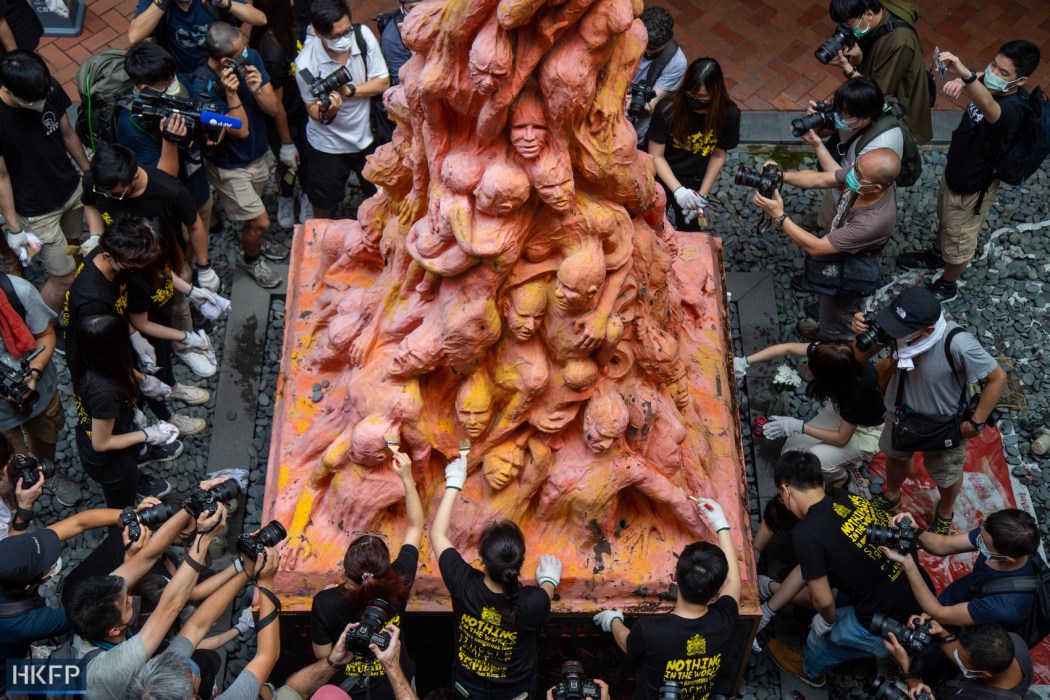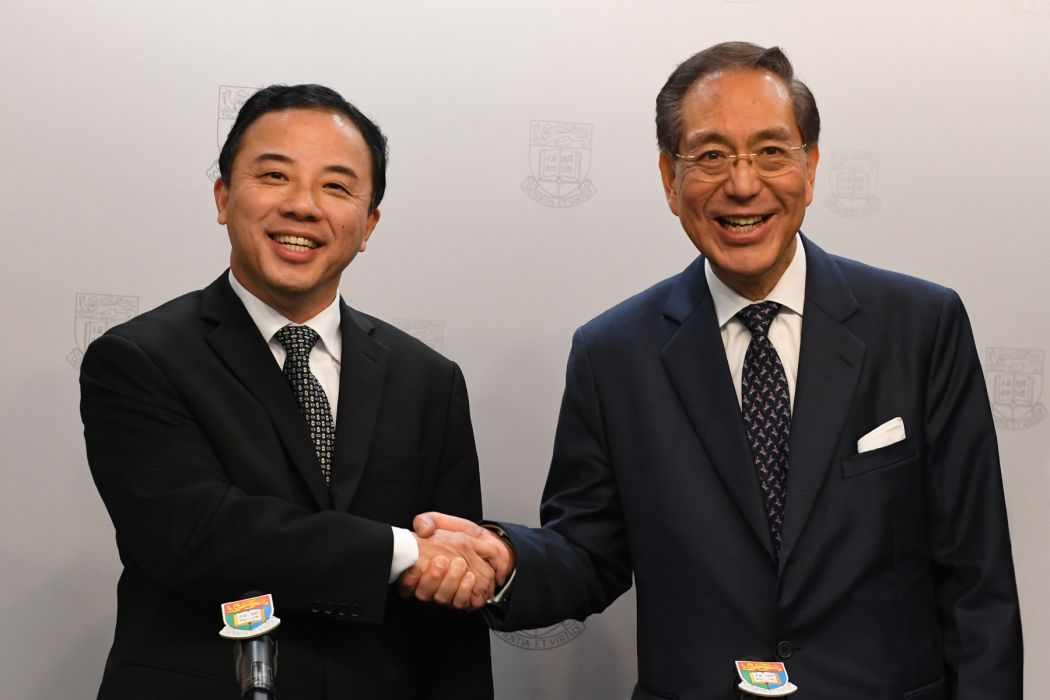Rights groups, activists and some academics have expressed shock after Hong Kong’s top university removed a controversial monument to Tiananmen Massacre victims in a closely-guarded overnight operation.

Workers at the University of Hong Kong (HKU) took away the eight-metre-high Pillar of Shame in two pieces on Wednesday night while students were on their Christmas break. The worksite was hidden behind covers and barricades and security guards kept reporters away.
Jason Wong, the only undergraduate representative on the university’s governing Council, told HKFP he was shocked that the statue had been removed just hours after the Council made the decision on Wednesday night.
Wong said he spoke out against the plan at the council meeting “but turns out I did not make any difference.”

“The statue had stood for more than 20 years, it had been there since I got into HKU.” Wong said, adding he felt uneasy when he saw the now empty space the Pillar of Shame had occupied.
The Tiananmen Massacre on June 4, 1989, ended months of student-led demonstrations in China. It is estimated that hundreds, perhaps thousands, of people died when the People’s Liberation Army was deployed to crack down on protesters in Beijing.

Hong Kong had marked the anniversary for decades until organisers of the candlelight vigil came under pressure as part of a growing clampdown on civil society under the Beijing-drafted national security law. Several have now been arrested.
The pillar was brought to the campus by students and others 24 years ago, after the last June 4 vigil before Hong Kong’s handover.

On Thursday morning the HKU Council issued a statement citing “potential safety issues” and “legal risks” based on the “Crimes Ordinance enacted under the Hong Kong colonial government” to support its decision to remove the artwork.
See also: Explainer: How Hong Kong sought to erase the memory of the 1989 Tiananmen Massacre
Some teaching staff expressed disapproval of the night-time operation.
Keith Richburg, director of the Journalism and Media Studies Centre at HKU, retweeted a post with the word “Shame!!!” as reporters posted footage of barricades surrounding the statue.
“You can destroy a statue. You can never destroy the memory of the June [4] massacre,” Richburg added later.
Under the cloak of darkness, with security prohibiting media access, the University single-handedly ‘enforces’ the NSL, absent any judicial scrutiny. #notmyHKU https://t.co/HTyzQwb79m
— dimsumthensome (@dimsumthensome) December 22, 2021
Sharron Fast, deputy director of HKU’s master’s programme in journalism, wrote on Twitter that “the university single-handedly ‘enforces’ the [National Security Law], absent any judicial scrutiny.”
‘Tombstone for freedom’
The removal of one of the few monuments commemorating the Tiananmen Massacre in Hong Kong also sparked an outcry among Hongkongers overseas and international human rights watchdogs.
Self-exiled former lawmaker Nathan Law said on Twitter that memories would live on even though the statue had gone.
The #PillarOfShame is removed, while memory lives.
— Nathan Law 羅冠聰 (@nathanlawkc) December 23, 2021
We must remember what happened on June 4th, 1989.#TiananmenMassacre https://t.co/sh4bAfVB4q
Samuel Chu, founder and president of the advocacy group “The Campaign for Hong Kong,” said the Pillar of Shame’s “creation in 1997 was a touchstone for freedom in Hong Kong,” while “its destruction in 2021 would be a tombstone for freedom in Hong Kong.”
Overseas activist Kwong Chung-ching spoke of her “crushing disappointment” at seeing the faculty leadership reduced to “accomplices” in a regime’s attempt “to force amnesia upon us.”
Amnesty International described the removal of the artwork as “another attack on freedom of expression in Hong Kong, and a shameful attempt to erase history.”
The removal of an iconic artwork that has stood in a university campus for 24 years commemorating those killed in the Tiananmen crackdown is another attack on freedom of expression in Hong Kong, and a shameful attempt to erase history. The Pillar of Shame must be preserved. https://t.co/F0g5uHCr8S
— amnestypress (@amnestypress) December 22, 2021
Maya Wang, a senior researcher on China at Human Rights Watch, told The Guardian the HKU move “signifies Beijing’s ever growing intolerance of dissent in Hong Kong” and the Chinese government was “rewriting history.”
‘Not quite clear who owns’
Jens Galschiøt, creator of the statue who also claims ownership of it, said he was “totally shocked that Hong Kong University is currently destroying the Pillar of Shame.”
Countries around the world had offered to receive The Pillar of Shame since HKU first sought its removal but there had been no response from the university or other authorities in Hong Kong.
The Danish sculptor said it shows “Hong Kong has become a brutal place without laws and regulations such as protecting the population, the arts and private property.” He said he would claim compensation for any damage to the sculpture.

The outgoing chief of the HKU Council, Arthur Li, said last week that it was “not quite clear who owns the Pillar of Shame… We’re still investigating.”
Support HKFP | Policies & Ethics | Error/typo? | Contact Us | Newsletter | Transparency & Annual Report | Apps
Help safeguard press freedom & keep HKFP free for all readers by supporting our team

LATEST FROM HKFP
HKFP has an impartial stance, transparent funding, and balanced coverage guided by an Ethics Code and Corrections Policy.
Support press freedom & help us surpass 1,000 monthly Patrons: 100% independent, governed by an ethics code & not-for-profit.










